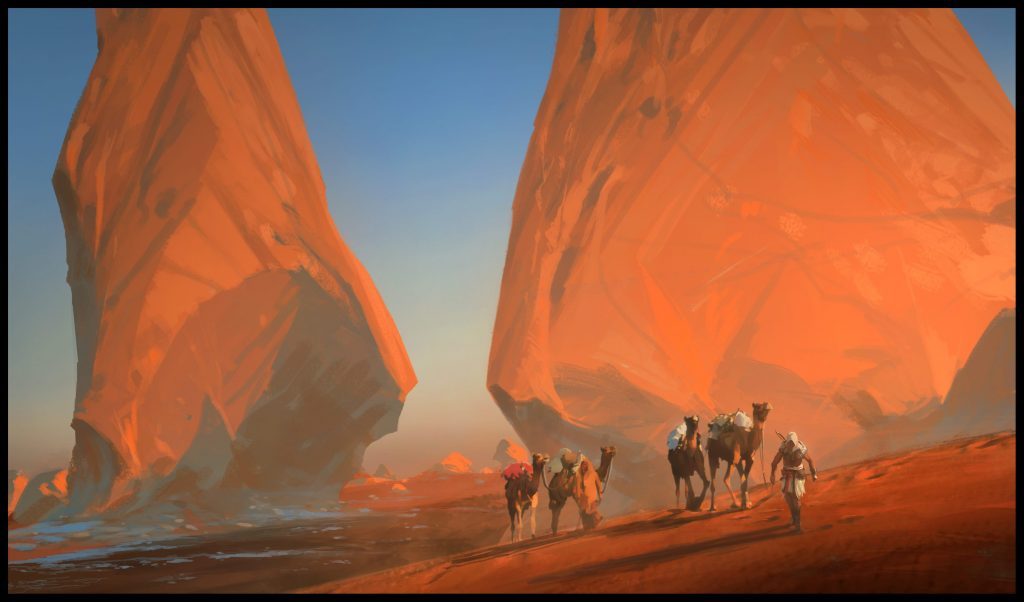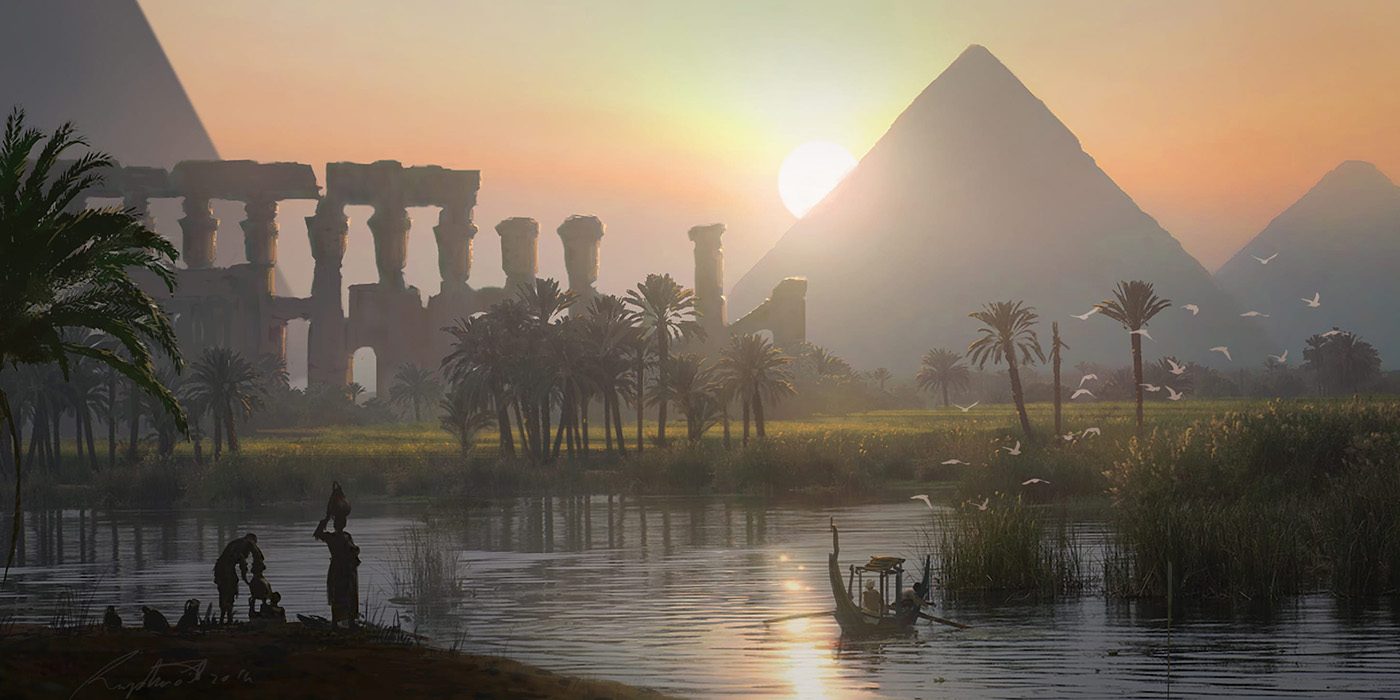Let’s celebrate the new Assassin’s Creed episode, Assassin’s Creed Origins with this exclusive interview with Raphael Lacoste
IAMAG : I had the chance to see your presentation about Black Flag and I’ve enjoyed seeing the creative process you’ve shared online. Whether it’s a personal project or for AC brand, it’s often about your passion for landscapes, composition and the relationship between different art; traditional drawing, photography, movies, design for games.
Can you tell me know more about this magic cocktail, the roots of the creative process when it comes to work on such iconic licence as AC? How do different kinds of art influence your vision?
Raphael Lacoste : I don’t have a specific process. Inspiration is work. It’s not something that falls from the sky. When we start, we find inspiration from many sources: paintings (traditional), photography, documentaries, books, exhibitions…. Sometimes, I work on simple compositions on paper. I take a photo of the sketch and bring the image to the next level in a digital painting.
I can start from a simple idea, an image i have in my mind, or from a place I visited, a photo I took, a painting I saw in an exhibition… there are many ways to be inspired.
Some traditional painters also inspired me a lot like Caspard David Friedrich, Moebius, Franklin Booth, Kazuo Oga, David Roberts…
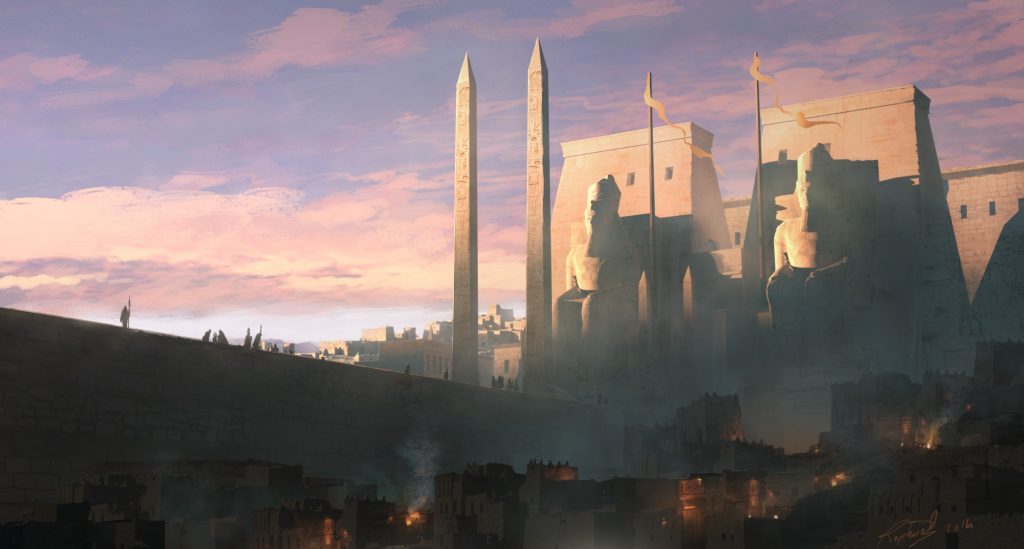
IA – In the past, you have mentioned that photography is a first great love that ties you back to your father. Was it an important part of you education, and is it still so today?
RL: My father gave me my first film camera when I was 14. I was always inspired by the photos he took when we lived in Algeria in 1975-77. I think even if he didn’t work as an artist, he still has a very good eye for photography and art; he is still a great photographer.
I am not sure my father was very enthusiastic to see me pursuing studies in Art. Fine Arts don’t necessarily lead to a steady job so it can be stressful for parents. But as far as I remember, my parents have always been supportive and helped me to go to art school and to become a professional artist, can’t be grateful enough!
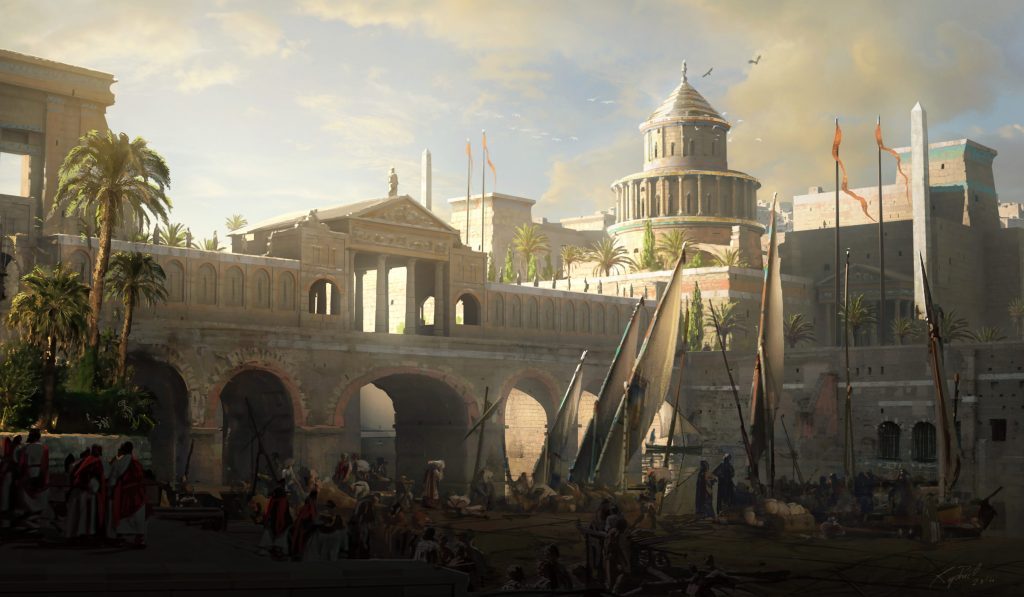
IA : AC is also all about the locations. Where and when do the actions take place? I guess it’s an endless challenge to immerse the gamers in a new universe?
RL : Yes it is, but we have so many exciting time periods and locations to visit, so the challenge is great this time, going back to an ancient time and recreating a whole country was a very demanding and difficult job, but it was also very fascinating.
This is the first time we go this far back in time and had to re-imagine and rebuild from scratch a seamless, full country. There is some documentation, for sure, we met historians and worked closely with them (like Jean Claude Golvin and Eveyne Ferron to name two). Ancient Egypt is a lost world, which gave us a lot of freedom to create the open world of the Video Game.

IA : Can you explain to our readers the creative journey, from early concept art to the ones that will be kept and used in the final game?
RL : Usually, when we know the time period of the game, and a bit of the story, the environment designs are kept as a visual standard for the whole production. Maybe it is because I stick to my direction and I don’t like to spin around in all directions. For sure, during conception we explore a lot, but when we know where the open world will be set, there isn’t much concept art going to the recycling bin. One thing that can take a lot of iterations is character design, because everybody can have an opinion on what a good visual should be for a hero.
There is also a lot more people involved in approvals for the characters of the game. They are depending on the story. If the story changes, the character will also need to change and this is something that will take a lot of iterations, way more than in environment design where I am the one and only client.
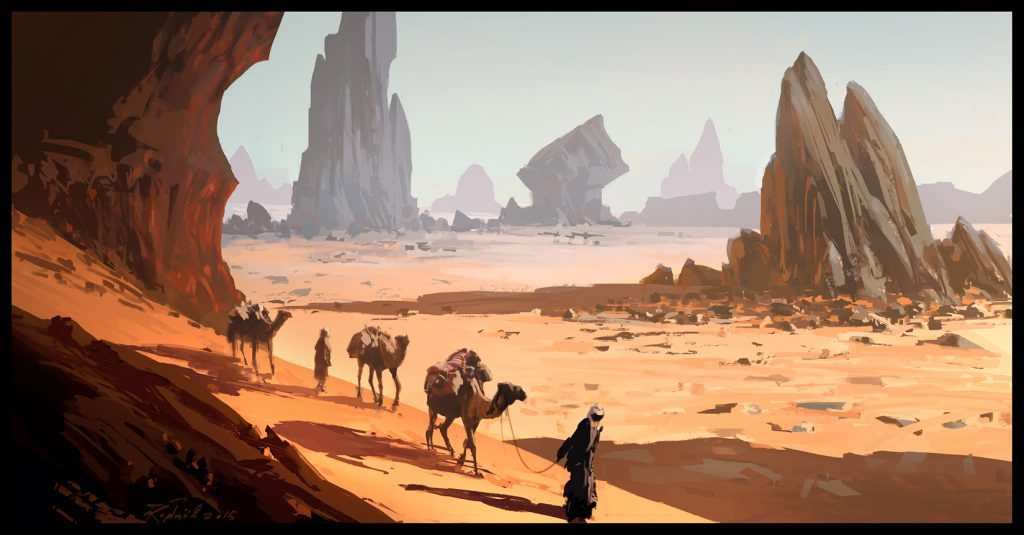
IA – Assassin’s Creed has reached the goal of ten chapters, seven spin-offs, numerous adaptations in different media. All its incarnations must be coherent with one another: how do you approach a franchise so big and the high expectations that come with it?
RL : I think, as you mentioned, seeing the number of titles, the strength of the franchise is to be able to reinvent various experiences and take many directions.
For me, working on a pirate game sounds completely different than re-creating an ancient Egyptian world. We also released very iconic and illustrative games with AC Chronicles, and explored many styles and art directions possible. This is the strength of the franchise; we don’t stick to only one way of making a product. We can question ourselves. We somehow keep iconic elements like the hooded figures, but are able to explore many styles and gameplay experiences.
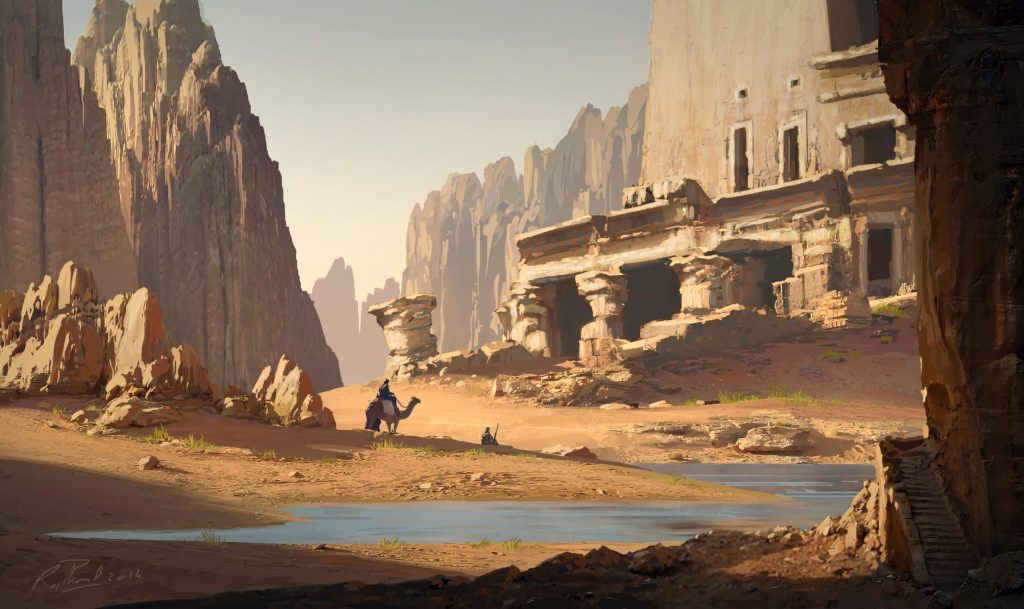
IA : The word, Origins, and the fact that the action takes place in Egypt, makes me think that you’ve done a lot of research to be able to depict what the origins of a civilization, culture, religion could be and how it could be represented in an interactive open world. Is this true?
RL : As I said, the action takes place in ancient times and we had to do a lot of research. During the early stages of conception, we read a lot of books, watched movies and talked to a few historians. I also had the chance with Martin Deschambault to go to Paris to meet Jean Claude Golvin in person. Since the beginning, we were very impressed with his art. His watercolours were some of our best benchmarks for historical reconstruction of ancient Egypt.
We spent a day with him and he gave us very useful advice, how Alexandria was built, how Siwa was created, how people lived and created their villages. After we met, we came back to Montreal and worked with him remotely. He produced dozens of original illustrations for us, very inspiring to recreate cities like Memphis, Alexandria, Siwa and Crocodilopolis!
IA : What are the best tools you used to make sure your vision was communicated to the world builders and was it difficult to keep the quality of the visual benchmarks in this huge playground?
RL : After conception and pre-production stage, environment illustrators are less busy doing high level concept art and illustrations. They focus more on helping out the team with quick sketches and paintovers.
The use of paintovers (basically means painting on an in-game screenshot of a Work In Progress layout) is extremely important in production as it helps to communicate our vision. We can do a couple hundred of these throughout production.
I really think that an image is worth 1000 words, it helps me to make sure that the overall composition works, the mood is interesting and terrain, textures, work well together with interesting blends.
Sometimes we see during reviews some layouts that make totally no sense in terms of credibility and functionality (see the joke with the upside-down elephant!), the Paintover will give inspiration to the world designers to rethink their basic layout and build something more credible and interesting for the player.
IA : How do you deal with the different illustrators, character designers, concept artists, level artists… to finally merge into one single global vision?
RL – As an artistic director, my role is to make sure the vision is unified, this is a great challenge I agree. Since early conception, we explore but try to find our own style. I personally try to stick to my vision and don’t like to spin around to different orientations. I think it’s important also to be able to make yourself some benchmarks, in 3D or in Photoshop, to show your vision to the artists. They usually really appreciate working with an art director who is able to get his hands dirty and show his vision through visual examples.
When we create such huge worlds like ACO, the work needs to be divided; I have 2-3 assistants working on different parts of the world and doing a daily follow up. This is really important to be able to keep the visual standard throughout the whole production.
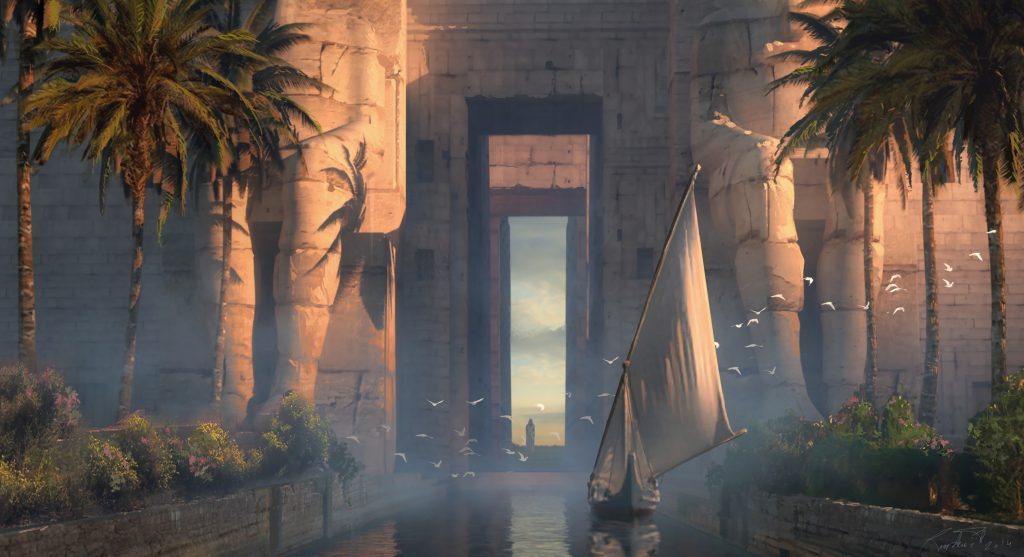
IA : How does the art department work with the technical department to set the bar and what are the constraints during the production phase? ?
RL : During pre-production, we established a few guidelines, but it is always difficult for the technical directors to set the exact frame and constraints when all the data isn’t there nor final.
We set the constraints throughout production, as the level artists and designers build the assets and the world. For instance, we have very dense forests and swamps in the Nile delta, only a few elevations. This could be a real nightmare for a technical director as we don’t have ways to occlude Alfa channels in the distance. Our tech guys found ways to play with density and shaders so we could keep the visual direction of the lush Nile delta, while keeping the performances.
Another thing, we not only explore the world from player’s perspective but also from the sky. With the eagle, we can see kilometers away and this was a real challenge for the technical team. Our TDs found ways to display beautiful levels of detail, optimized assets and lighting shaders, allowing the player to almost seamlessly switch between Bayek and Senu, his eagle.
https://www.youtube.com/watch?v=GWddPgKIjCc
IA : As an art director, you have to work with artists from all over the world and from different cultures. Can you feel the influences of the culture of some artists in their concepts and how it can bring in more powerful ideas or limitations or new directions?
RL : Indeed! I work with Ubisoft Sofia, based in Bulgaria, also Ubisoft Montpellier (France), Ubisoft Singapore… Ubisoft Shanghai.
The final numbers can reach 800 in terms of total people working on the project. This is pretty insane. In terms of Artistic Departments, I have a very good connection with Eddie Benun working for Ubisoft Sofia and Mohamed Gambouz, Art director in Singapore. We have some regular calls, catch ups but everything went smoothly on Origins. The team in Sofia and Singapore did an amazing job, bringing their culture and own passion to the project. This was really incredible to have their contribution to the project and helped us to have a step back and see differently how we picture and plan our production in Montreal with the dev team.
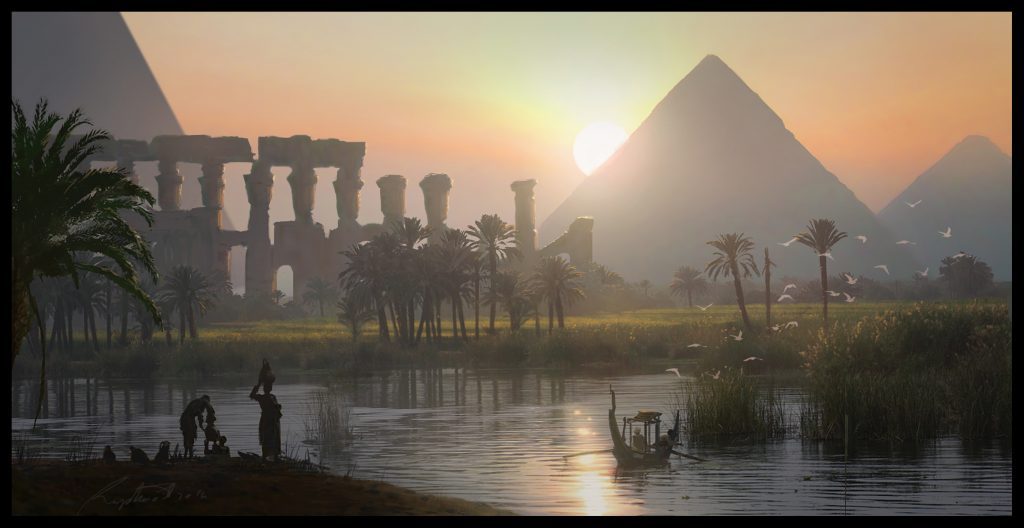
IA : AC Origins seems to have challenged the technology of the last generation of consoles, but also the artists. We have not seen many screenshots yet, but those who have been published unveil in my opinion a new approach to light, mood. What choices have you made regarding the art direction of these parts?
RL : The game looks absolutely amazing on Xbox one X on a 4K TV HDR. This is unbelievable; you need to see it to believe it. I have played many games like Horizon, Witcher, GTA, which I absolutely love in terms of artistic direction, but AC Origins is going to impress a lot with the visual quality of the lighting, composition and drawing distance.
The lighting is using a new rendering engine, recreated from scratch by our best engineers. It is allowing us to render in real time a physically based lighting with global illumination and a sky model with procedural clouds, stars, working in real time for a 24-hour cycle.
The world looks very impressive also thanks to the lighting and rendering, not only because of the visual composition. As the lighting is a physical simulation, we had to make some artistic choices though, allowing our lighting artists to create specific moods, dramatic moments in the lighting and atmosphere. We created tools to give them more control, like atmospherics parameters and colour grading.
https://www.youtube.com/watch?v=3TBrB87k2f8
IA: How does one go about creating a complex universe like Assassin’s Creed? And how much of the different aspects of AC come from you and your input? How much imagination impacted on the franchise?
RL: Sometimes we have more or less impact on the choices of settings and characters as artists and directors, but we play key roles in the creation of a new instalment of an AC game.
For instance, I had this idea of a badass hero riding a horse in a desert with his eagle, a bit like Mongolian Fox hunters…
We ended with a very iconic hero in Assassin’s Creed Origins: an Egyptian Medjay riding a camel in Egypt, and using his eagle to scout the landscape ahead of him.
The story and gameplay mechanics didn’t come from me, but the original visual idea of the hero was first a simple sketch and ended as a way deeper and more complex character. Images have great power and can inspire a whole team! This is why I think concept art and illustrations are so important.
Another point is that if you work on a realistic and credible environment designed world, like in Assassin’s Creed, you still have to make artistic decisions related to style, scale and scenery to create a memorable and epic experience!
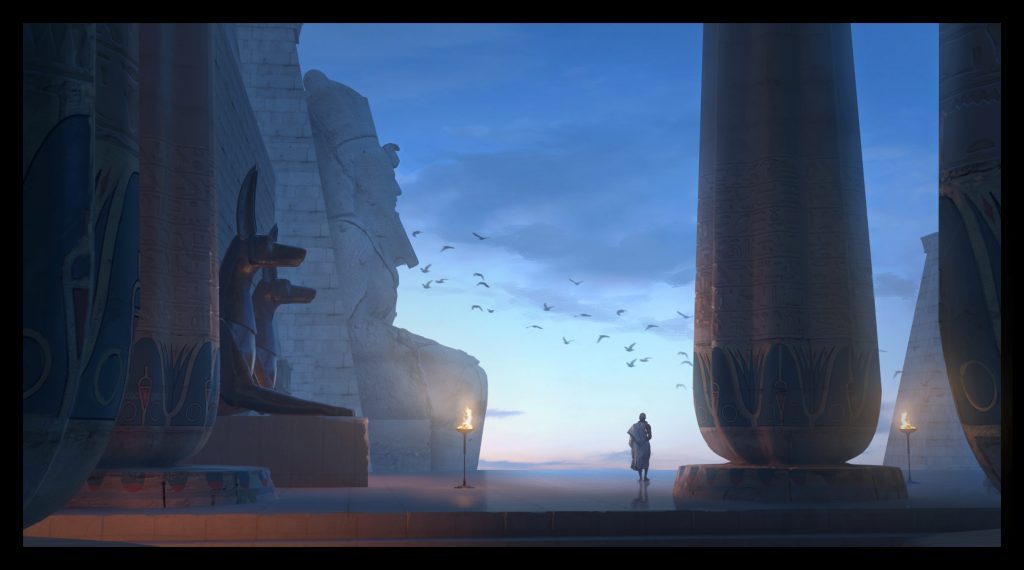
IA : Egypt has always been a powerful country for the imagination, the movie industry, myths, but also some classic paintings. Have you built a collection of old paintings and photography references to fuel your inspiration? ?
RL : Yes, for sure! In our early stages of conception, we looked at traditional painters like Jean Leon Gerome, David Roberts, Sir Lawrence Alma Tadema, Ludwig Deutsh and even Paul Lasaine for the more recent artists who gave us inspiration !
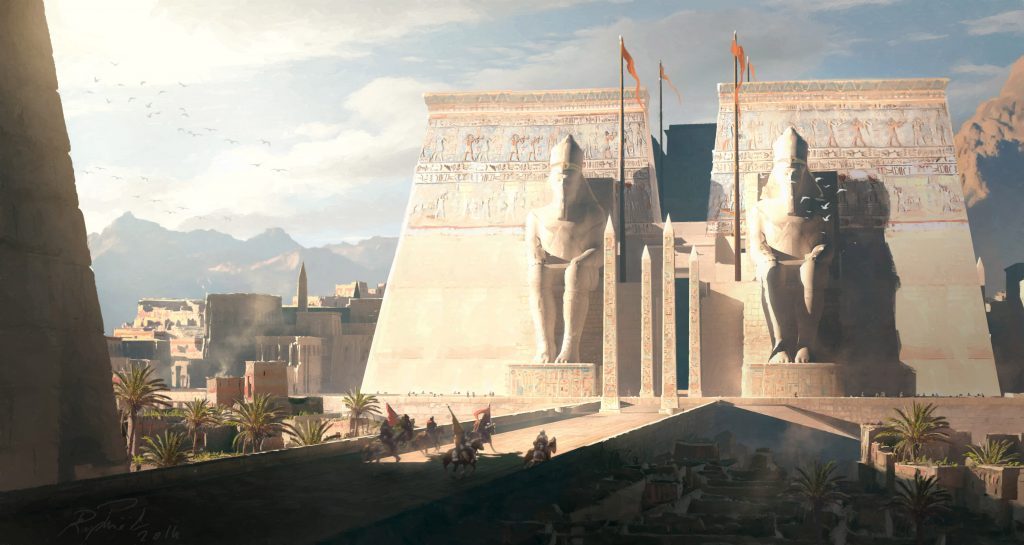
IA : How many concept artists have worked on this project?
RL : In terms of illustrators, in Montreal the lead studio, mainly Martin Deschambault , Jeff Simpson and I , Gilles Beloeil and Vincent Gaigneux joined us also for a part of the production. We were about 10 total worldwide in terms of concept art.
https://www.youtube.com/watch?v=aqqZZ4rUYQE
IA : What does it mean to be a Brand Art Director?
RL : Being a Brand or Franchise Art Director means that I not only have to work on my project (the last one being AC Origins) but also help other Artistic Directors on their conception and projects. I also have to give feedback on some products like figures, comics and art books created by the brand team. I am literally responsible for the visual standard of the franchise and make sure we ship the most beautiful and immersive games possible.
https://www.youtube.com/watch?v=P3MAHboKg0U
IA : In what ways has the production experience of AC Origins been different from other episodes you have directed and why?
RL : It was very different. First it was a long production (4 years) so we had a lot of ups and downs. It was a very challenging project as we had to recreate a huge world and the systems, gameplay features were completely new.
We needed time to align our visions and make a single, epic, fun, seamless and memorable experience. We are very proud of what we created on AC Origins but it was a tough production. There is no glory without challenges, so now, we hope our game will have the deserved success. Let’s celebrate!
